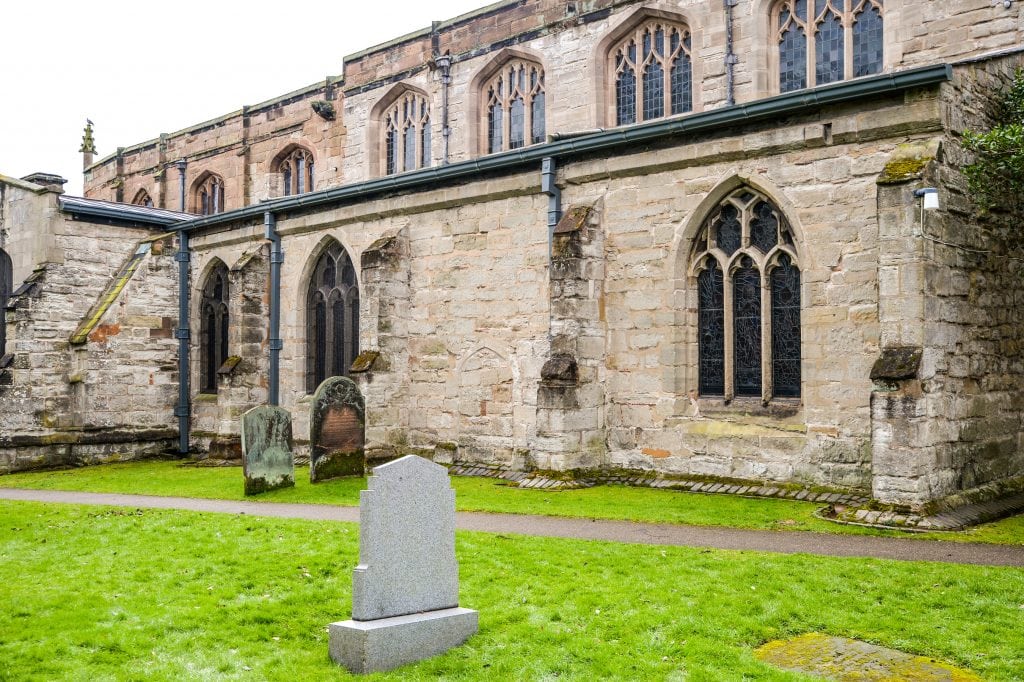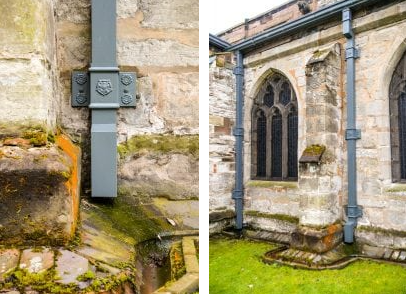Ruling in favour of GRP rainwater goods on 600 year old church
 The theft of lead roofing materials from churches, community halls and the like has become an increasing problem within the ecclesiastical fraternity, amounting to money being wasted in continual replacement of goods.
The theft of lead roofing materials from churches, community halls and the like has become an increasing problem within the ecclesiastical fraternity, amounting to money being wasted in continual replacement of goods.
One church which experienced such theft after having installed replacement lead, under the guidance of the Diocesan Advisory Commission (DAC), was Knowle Parish Church situated in the village of Knowle, Solihull. It was after the latest theft that the church decided to fight back and press for the acceptance of a system that had the look of lead so to be in keeping with the heritage of the church but ultimately wasn’t and so of no interest to thieves.
It was in the Quinquennial Review in 2008 that due to their poor condition it was identified that the North Aisle rainwater system (gutters and downpipes) at Knowle Church was in need of replacement. Aware of the vulnerability of Lead to theft, a cast iron system was proposed by the PCC but was rejected outright by the DAC because on historical grounds they still required Lead as the replacement material.
So it was that the DAC requested Lead rainwater system be installed in 2009 where only 2 years later it was subsequently removed by thieves late in 2011.
“At that point in time, members of the Church Parochial Church Council (PCC) recognised that it was a total waste of time and money continuing to replace the Rainwater Goods with lead and so a more permanent solution had to be found “commented Professor Derek Sheldon, Chairman of the PCC Fabric Committee”
After an investigation by the Knowle PCC Fabric team into suitably aesthetically pleasing, functional non-lead products, a GRP rainwater system was found and proposed to the DAC.
 Manufactured by Yeoman Rainguard in Leeds, GRP is a light weight yet durable material and has been approved for replacement rainwater systems on listed buildings in the past.
Manufactured by Yeoman Rainguard in Leeds, GRP is a light weight yet durable material and has been approved for replacement rainwater systems on listed buildings in the past.
The manufacturing process of the GRP gutters and down pipes allows the capability of adding decorative motives, dates and designs which can be fabricated to match original and existing ones.
Along with a choice of colours, including a lead effect finish these properties allow the rainwater system to be in keeping with the architectural heritage of the building.
Being UV stable the products will not diminish in colour overtime and require no maintenance other than a periodical clean out.
Easy to handle and install – yet worthless to any passing thief – The downpipes and gutters certainly look the part on historical and heritage buildings.
The GRP rainwater system was reluctantly agreed to by the DAC and was erected in November 2012 under a temporary licence (a permanent faculty was rejected outright) issued by the Diocesan Chancellor – this was because serious rain damage was occurring to special parts of the church building without any rainwater system in place.
It was after this that the Knowle PCC had to start jumping through hoops to try gain a permanent licence for the cost saving GRP rainwater system. As a requirement of the temporary licence they were required to get both a West Midlands (WM) police theft audit review and planning approval for the GRP of which the latter was refused.
The WM police review recommended an alternative to lead to minimise the threat of theft and fully supported the GRP product.
The planning refusal led to an enforcement notice being served in August 2016 against which Knowle PCC successfully appealed to the Government Planning Inspector.
At some significant cost the PCC called in Planning and Archaeology specialists, plus over 130 letters of support from a good part of the church congregation in their Appeal.
 The success of this appeal was ultimately based on the ruling of the Inspector that the GRP rainwater goods have not affected the external appearance to a material degree and therefore do not amount to “development” in terms of planning acts.
The success of this appeal was ultimately based on the ruling of the Inspector that the GRP rainwater goods have not affected the external appearance to a material degree and therefore do not amount to “development” in terms of planning acts.
The appeal was successfully upheld in April 2017 and after almost 6 months of consideration following continued objections from the DAC and most historical bodies the Chancellor granted a faculty in October 2017 to retain the GRP goods for at least a further 5 years to “ensure the durability of the GRP installation”
“This limitation should not prove to be a problem as we have been advised by Yeoman Rainguard that this durable GRP material will last for over 30 years or more, allowing not only piece of mind that theft of the rainwater systems will be a thing of the past but also ensuring church funds will be protected and used primarily for the mission of the church.” concluded Professor Sheldon.
Whilst GRP has been used extensively on the exterior of Dublin Cathedral (some of which was supplied again by Yeoman Rainguard), this particular case was the first in the UK and a unique approval of GRP Rainwater Goods for Grade 1 listed buildings by a Diocesan Chancellor.
“Given that it is the first of its kind in the UK it should be a very useful precedent for other churches finding themselves in such an impossible situation” says Professor Sheldon.
To find out more about Yeoman Shield GRP rainwater products and services please call 0113 279 5854 or go to the website www.rainguard.co.uk.













